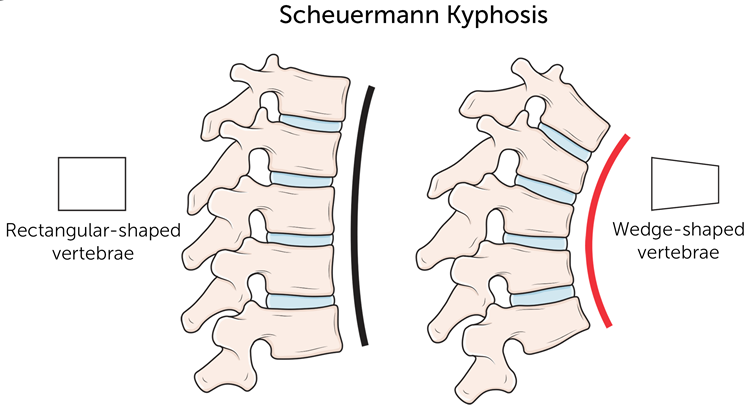
How physiotherapy treats Scheuermann’s kyphosis
Children and adolescents go through periods of rapid growth and are prone to suffering a range of musculoskeletal complaints of the spine.
Danish radiologist Holger Scheuermann first described this juvenile kyphosis in 1921 when he reported on 105 adolescent patients suffering from a unique curvature of the upper part of the spine.[1]
Scheuermann’s kyphosis is a structural deformity of the thoracic spine and the most common cause of kyphosis during adolescence. Scheuermann’s kyphosis has been known as apprentice’s kyphosis as it was detected mainly in young people involved in heavy labour.
Scheuermann’s is often attributed to poor posture, which can delay diagnosis as well as treatment.
What are the symptoms of Scheuermann’s kyphosis?
The onset of Scheuermann’s usually occurs around puberty and pain, when present, is commonly mild and is brought on by prolonged periods of sitting or exercise and is usually located near the apex of the deformity.
In the early phases of the disease posture changes might not be visible yet but back pain may be present. In children who have not yet developed pain at the level of kyphosis or in the lower back, the presenting symptom is often poor posture or rounded shoulders that has alarmed their parents.[2]
In this condition, some vertebrae in the upper spine are shaped like a wedge instead of a rectangle, causing the curve.
- Physical exam shows rigid hyperkyphotic curve, accentuated with forward bending.
- Hyperkyphosis does not resolve with an extension or lying prone/supine, further supporting the “rigid” nature of this deformity.
Other potential symptoms include:
- reduced range of movement
- mobility problems
- weakness
- Fatigue
- Tight hamstrings
- Loss of flexibility
- Slouching, or posture that gets worse over time
Postural kyphosis is readily differentiated from Scheuermann kyphosis radiographically because of the presence of a uniformly rounded kyphosis that is nonstructural, and the absence of wedging of vertebral bodies and disc degeneration. [3]
What are the long term outlooks for Scheuermann kyphosis?
A study by Murray et al detailed a long-term follow-up of 67 patients with thoracic Scheuermann kyphosis and found that 38% of the patients had significant interference with activities of daily living because of pain, worked in lighter jobs than did the controls and had more severe back pain.[4]
With early intervention and physiotherapy, most people with Scheuermann kyphosis have no long term problems.
Children with Scheuermann kyphosis can:
- Do exercises to stretch and strengthen the back
- Avoid activities that cause pain
- Wear a back brace
General objectives of physiotherapy treatment
A physiotherapist is important in the management of Scheuermann’s disease by being able to assist in diagnosing the problem in a referral for an X-ray and then devising a management plan for treatment. Your physiotherapist will use a number of treatment tools to reduce your pain and inflammation. These might include ice, activity modification, treatments to reduce back pain, and stretching or strengthening exercises designed to assist with their posture hydrotherapy, dry needling and soft tissue massage.
However, kyphosis exercises alone won’t reduce abnormal curvature of the spine. In some cases, your child might benefit from a kyphosis back brace to prevent the curvature from worsening. Bracing typically holds the spine straight during growth and prevents the kyphosis from progressing in children younger than 14. If your child wears the kyphosis brace consistently, the curvature is usually corrected after two years.
If your child has Scheuermann’s disease, at Lane Cove physio we will create a customised plan that fits your child’s unique needs.
[1] Scheuermann HW (1921) Kyphosis dorsalis juvenalis (trans by Dr. Hirsch). Z Orthop Chir 51:305 –317
[2] Sorenson KH. Scheuermann’s Juvenile Kyphosis. Cophenagen: Munksgaard; 1964.
[3] Gennari JM, Themar-Noel C, Panuel M, et al. Adolescent spinal pain: The pediatric orthopedist’s point of view. Orthop Traumatol Surg Res 2015; 101:S247.
[4] Murray PM, Weinstein SL, Spratt KF. The natural history and long-term follow-up of Scheuermann kyphosis. J Bone Joint Surg Am. 1993 Feb;75(2):236-48. doi: 10.2106/00004623-199302000-00011. PMID: 8423184.



